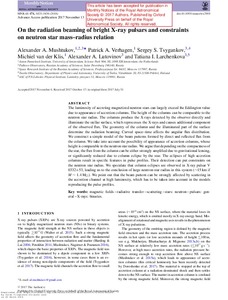On the radiation beaming of bright X-ray pulsars and constraints on neutron star mass-radius relation
Michiel van der Klis; Alexander A Mushtukov; Patrick A Verhagen; Sergey S Tsygankov; Tatiana I Larchenkova; Alexander A Lutovinov
On the radiation beaming of bright X-ray pulsars and constraints on neutron star mass-radius relation
Michiel van der Klis
Alexander A Mushtukov
Patrick A Verhagen
Sergey S Tsygankov
Tatiana I Larchenkova
Alexander A Lutovinov
OXFORD UNIV PRESS
Julkaisun pysyvä osoite on:
https://urn.fi/URN:NBN:fi-fe2021042718849
https://urn.fi/URN:NBN:fi-fe2021042718849
Tiivistelmä
The luminosity of accreting magnetized neutron stars can largely exceed the Eddington value due to appearance of accretion columns. The height of the columns can be comparable to the neutron star radius. The columns produce the X-rays detected by the observer directly and illuminate the stellar surface, which reprocesses the X-rays and causes additional component of the observed flux. The geometry of the column and the illuminated part of the surface determine the radiation beaming. Curved space-time affects the angular flux distribution. We construct a simple model of the beam patterns formed by direct and reflected flux from the column. We take into account the possibility of appearance of accretion columns, whose height is comparable to the neutron star radius. We argue that depending on the compactness of the star, the flux from the column can be either strongly amplified due to gravitational lensing, or significantly reduced due to column eclipse by the star. The eclipses of high accretion columns result in specific features in pulse profiles. Their detection can put constraints on the neutron star radius. We speculate that column eclipses are observed in X-ray pulsar V 0332+53, leading us to the conclusion of large neutron star radius in this system (similar to 15 km if M similar to 1.4 M-circle dot). We point out that the beam pattern can be strongly affected by scattering in the accretion channel at high luminosity, which has to be taken into account in the models reproducing the pulse profiles.
Kokoelmat
- Rinnakkaistallenteet [19218]
